sensor Acura RDX 2019 Service Manual
[x] Cancel search | Manufacturer: ACURA, Model Year: 2019, Model line: RDX, Model: Acura RDX 2019Pages: 649, PDF Size: 33 MB
Page 447 of 649
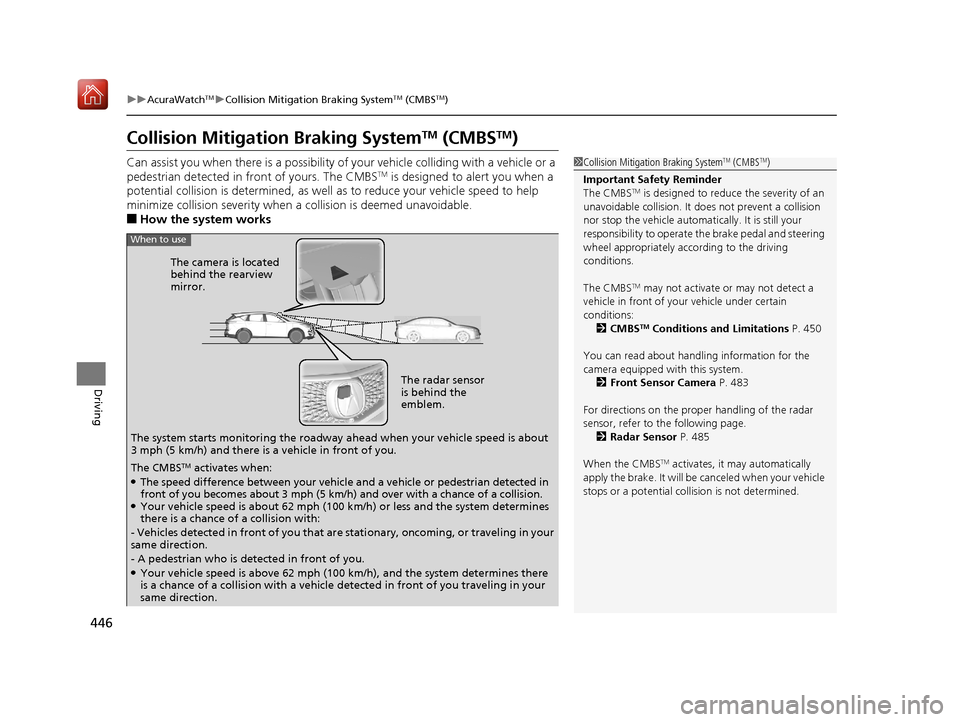
446
uuAcuraWatchTMuCollision Mitigation Braking SystemTM (CMBSTM)
Driving
Collision Mitigati on Braking SystemTM (CMBSTM)
Can assist you when there is a possibility of your vehicle colliding with a vehicle or a
pedestrian detected in front of yours. The CMBSTM is designed to alert you when a
potential collision is determined, as well as to reduce your vehicle speed to help
minimize collision severity when a collision is deemed unavoidable.
Ō¢ĀHow the system works
1 Collision Mitigation Braking SystemTM (CMBSTM)
Important Safety Reminder
The CMBS
TM is designed to reduce the severity of an
unavoidable collision. It do es not prevent a collision
nor stop the vehicle automati cally. It is still your
responsibility to operate the brake pedal and steering
wheel appropriately acco rding to the driving
conditions.
The CMBS
TM may not activate or may not detect a
vehicle in front of y our vehicle under certain
conditions: 2 CMBS
TM Conditions and Limitations P. 450
You can read about handling information for the
camera equipped with this system. 2 Front Sensor Camera P. 483
For directions on the prop er handling of the radar
sensor, refer to the following page. 2 Radar Sensor P. 485
When the CMBS
TM activates, it may automatically
apply the brake. It will be canceled when your vehicle
stops or a potential coll ision is not determined.
The radar sensor
is behind the
emblem.
The camera is located
behind the rearview
mirror.
The system starts monitoring the roadway ah ead when your vehicle speed is about
3 mph (5 km/h) and there is a vehicle in front of you.
When to use
The CMBSTM activates when:ŌŚÅThe speed difference between your vehicle and a vehicle or pedestrian detected in
front of you becomes about 3 mph (5 km/h) and over with a chance of a collision.
ŌŚÅYour vehicle speed is about 62 mph (100 km/h) or less and the system determines
there is a chance of a collision with:
- Vehicles detected in front of you that ar e stationary, oncoming, or traveling in your
same direction.
- A pedestrian who is detected in front of you.
ŌŚÅYour vehicle speed is above 62 mph (100 km/h), and the system determines there
is a chance of a collision with a vehicle detected in front of you traveling in your
same direction.
19 ACURA RDX-31TJB6000.book 446 ŃāÜŃā╝ŃéĖ ’╝Æ’╝É’╝æ’╝śÕ╣┤’╝öµ£ł’╝Æ’╝¢µŚźŃĆƵ£©µø£µŚźŃĆĆÕŹłÕŠī’╝öµÖé’╝Ģ’╝æÕłå
Page 449 of 649

448
uuAcuraWatchTMuCollision Mitigation Braking SystemTM (CMBSTM)
Driving
The system has three alert stages for a possible collision. However, depending on circumstances, the CMBSTM may not go through all of
the stages before initiating the last stage.
Ō¢ĀCollision Alert Stages
Distance between vehiclesCMBSTM
The radar sensor detects a vehicleAudible & Visual WARNINGSBraking
Stage oneThere is a risk of a collision with the
vehicle ahead of you.
When in Long , visual and audible alerts come
on at a longer distance from a vehicle ahead
than in Normal setting, and in Short, at a
shorter distance than in Normal.
ŌĆö
Stage
twoThe risk of a collision has increased,
time to respond is reduced.
Visual and audible alerts.
Lightly
applied
Stage
three The CMBSTM determines that a
collision is unavoidable.Forcefully applied
Your Vehicle Vehicle
Ahead
Normal
Short
Long
Your
Vehicle Vehicle
Ahead
Your
VehicleVehicle
Ahead
19 ACURA RDX-31TJB6000.book 448 ŃāÜŃā╝ŃéĖ ’╝Æ’╝É’╝æ’╝śÕ╣┤’╝öµ£ł’╝Æ’╝¢µŚźŃĆƵ£©µø£µŚźŃĆĆÕŹłÕŠī’╝öµÖé’╝Ģ’╝æÕłå
Page 451 of 649
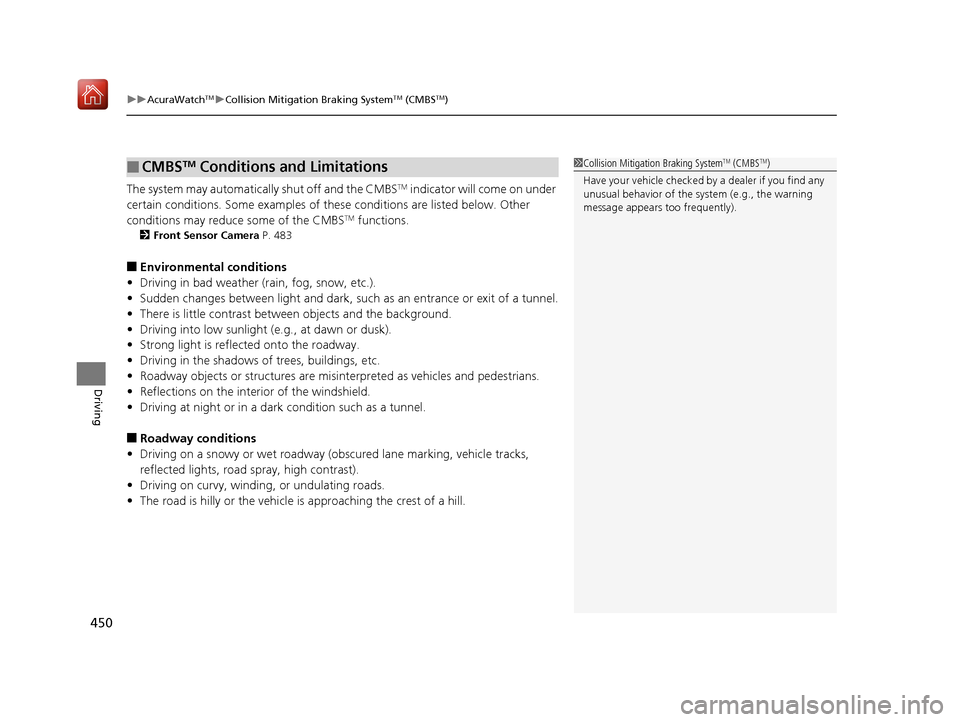
uuAcuraWatchTMuCollision Mitigation Braking SystemTM (CMBSTM)
450
Driving
The system may automatically shut off and the CMBSTM indicator will come on under
certain conditions. Some examples of th ese conditions are listed below. Other
conditions may reduce some of the CMBS
TM functions.
2 Front Sensor Camera P. 483
Ō¢ĀEnvironmental conditions
ŌĆó Driving in bad weather (rain, fog, snow, etc.).
ŌĆó Sudden changes between light and dark, such as an entrance or exit of a tunnel.
ŌĆó There is little contrast between objects and the background.
ŌĆó Driving into low sunlight (e.g., at dawn or dusk).
ŌĆó Strong light is reflected onto the roadway.
ŌĆó Driving in the shadows of trees, buildings, etc.
ŌĆó Roadway objects or structures are misint erpreted as vehicles and pedestrians.
ŌĆó Reflections on the interi or of the windshield.
ŌĆó Driving at night or in a dark condition such as a tunnel.
Ō¢ĀRoadway conditions
ŌĆó Driving on a snowy or wet roadway (obscured lane marking, vehicle tracks,
reflected lights, road spray, high contrast).
ŌĆó Driving on curvy, winding, or undulating roads.
ŌĆó The road is hilly or the vehicle is approaching the crest of a hill.
Ō¢ĀCMBSTM Conditions and Limitations1Collision Mitigation Braking SystemTM (CMBSTM)
Have your vehicle checked by a dealer if you find any
unusual behavior of the system (e.g., the warning
message appears too frequently).
19 ACURA RDX-31TJB6000.book 450 ŃāÜŃā╝ŃéĖ ’╝Æ’╝É’╝æ’╝śÕ╣┤’╝öµ£ł’╝Æ’╝¢µŚźŃĆƵ£©µø£µŚźŃĆĆÕŹłÕŠī’╝öµÖé’╝Ģ’╝æÕłå
Page 452 of 649
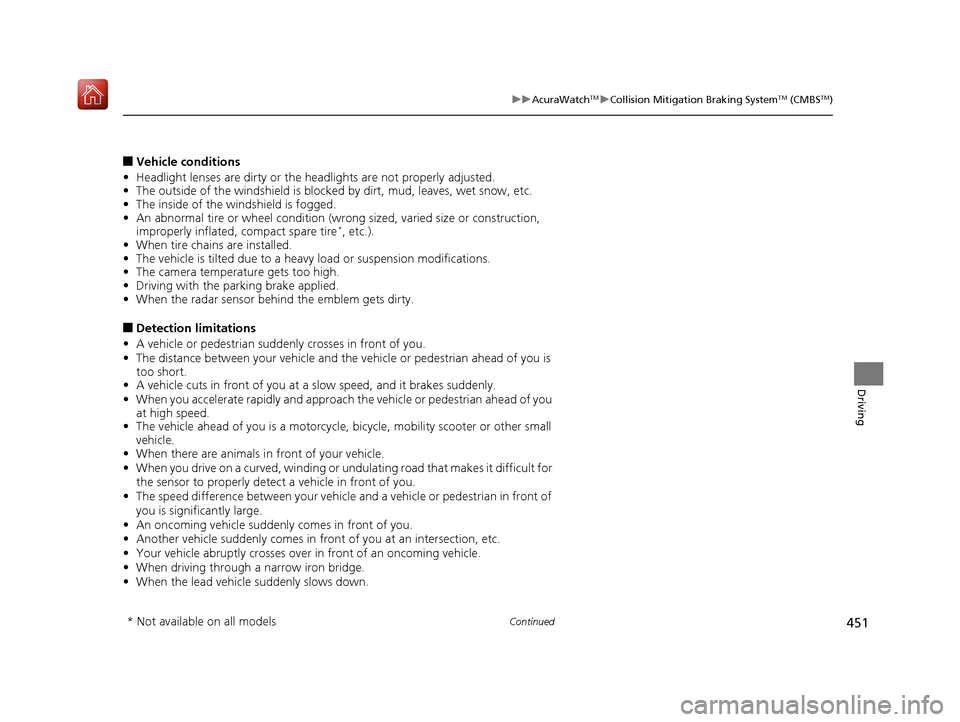
451
uuAcuraWatchTMuCollision Mitigation Braking SystemTM (CMBSTM)
Continued
Driving
Ō¢ĀVehicle conditions
ŌĆó Headlight lenses are dirty or the h eadlights are not properly adjusted.
ŌĆó The outside of the windshield is blocked by dirt, mud, leaves, wet snow, etc.
ŌĆó The inside of the windshield is fogged.
ŌĆó An abnormal tire or wheel condition (wro ng sized, varied size or construction,
improperly inflated, compact spare tire
*, etc.).
ŌĆó When tire chains are installed.
ŌĆó The vehicle is tilted due to a heavy load or suspension modifications.
ŌĆó The camera temperature gets too high.
ŌĆó Driving with the parking brake applied.
ŌĆó When the radar sensor behind the emblem gets dirty.
Ō¢ĀDetection limitations
ŌĆó A vehicle or pedestrian suddenly crosses in front of you.
ŌĆó The distance between your vehicle and the vehicle or pedestrian ahead of you is
too short.
ŌĆó A vehicle cuts in front of you at a slow speed, and it brakes suddenly.
ŌĆó When you accelerate rapidly and approach the vehicle or pedestrian ahead of you
at high speed.
ŌĆó The vehicle ahead of you is a motorcycle, bicycle, mobility scooter or other small
vehicle.
ŌĆó When there are animals in front of your vehicle.
ŌĆó When you drive on a curved, winding or und ulating road that makes it difficult for
the sensor to properly detect a vehicle in front of you.
ŌĆó The speed difference between your vehicle an d a vehicle or pedestrian in front of
you is significantly large.
ŌĆó An oncoming vehicle suddenly comes in front of you.
ŌĆó Another vehicle suddenly comes in front of you at an intersection, etc.
ŌĆó Your vehicle abruptly crosses over in front of an oncoming vehicle.
ŌĆó When driving through a narrow iron bridge.
ŌĆó When the lead vehicl e suddenly slows down.
* Not available on all models
19 ACURA RDX-31TJB6000.book 451 ŃāÜŃā╝ŃéĖ ’╝Æ’╝É’╝æ’╝śÕ╣┤’╝öµ£ł’╝Æ’╝¢µŚźŃĆƵ£©µø£µŚźŃĆĆÕŹłÕŠī’╝öµÖé’╝Ģ’╝æÕłå
Page 454 of 649

Continued453
uuAcuraWatchTMuCollision Mitigation Braking SystemTM (CMBSTM)
Driving
The CMBSTM may activate even when you are aware of a vehicle ahead of you, or
when there is no vehicle ahead. Some examples of this are:
Ō¢ĀWhen Passing
Your vehicle approaches another vehicle ah ead of you and you change lanes to pass.
Ō¢ĀAt an intersection
Your vehicle approaches or passes another ve hicle that is making a left or right turn.
Ō¢ĀWith Little Chance of a Collision1With Little Chance of a Collision
Do not paint, or apply any coverings or paint to radar
sensor area. This can impact CMBS
TM operation.
19 ACURA RDX-31TJB6000.book 453 ŃāÜŃā╝ŃéĖ ’╝Æ’╝É’╝æ’╝śÕ╣┤’╝öµ£ł’╝Æ’╝¢µŚźŃĆƵ£©µø£µŚźŃĆĆÕŹłÕŠī’╝öµÖé’╝Ģ’╝æÕłå
Page 456 of 649
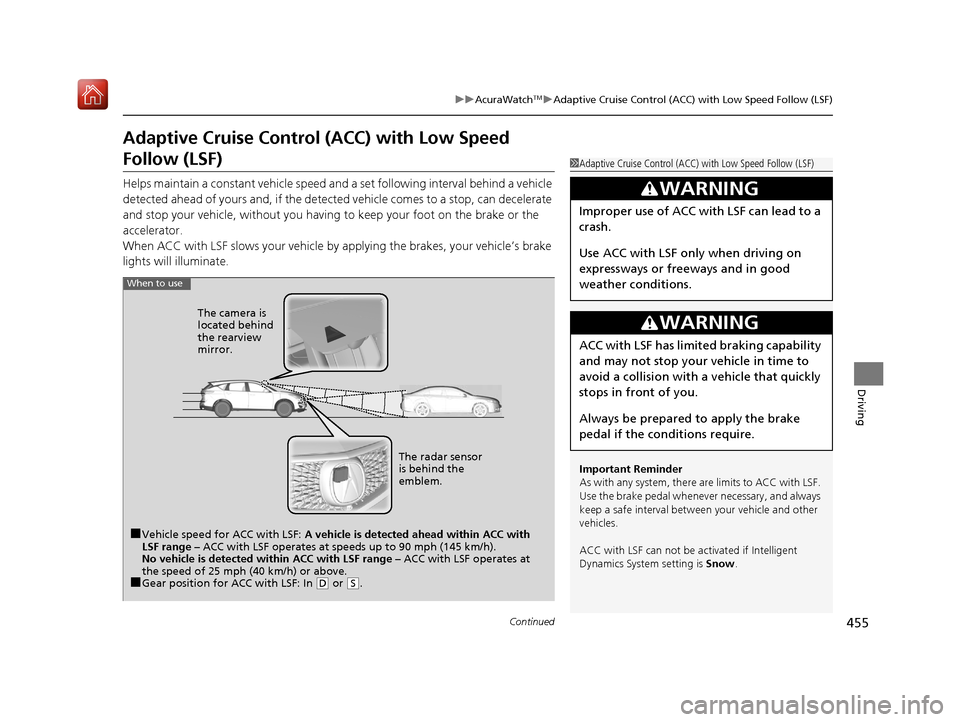
455
uuAcuraWatchTMuAdaptive Cruise Control (ACC) with Low Speed Follow (LSF)
Continued
Driving
Adaptive Cruise Control (ACC) with Low Speed
Follow (LSF)
Helps maintain a constant vehicle speed and a set following interval behind a vehicle
detected ahead of yours and, if the detect ed vehicle comes to a stop, can decelerate
and stop your ve hicle, without yo u having to keep your foot on the brake or the
accelerator.
When ACC with LSF slows your vehicle by applying the brakes, your vehicleŌĆÖs brake
lights will illuminate.
1 Adaptive Cruise Control (ACC) with Low Speed Follow (LSF)
Important Reminder
As with any system, there are limits to ACC with LSF.
Use the brake pedal whenever necessary, and always
keep a safe interval between your vehicle and other
vehicles.
ACC with LSF can not be activated if Intelligent
Dynamics System setting is Snow.
3WARNING
Improper use of ACC wi th LSF can lead to a
crash.
Use ACC with LSF only when driving on
expressways or freeways and in good
weather conditions.
3WARNING
ACC with LSF has limited braking capability
and may not stop your vehicle in time to
avoid a collision with a vehicle that quickly
stops in front of you.
Always be prepared to apply the brake
pedal if the conditions require.
When to use
Ō¢ĀVehicle speed for ACC with LSF: A vehicle is detected ahead within ACC with
LSF range ŌĆō ACC with LSF operates at speeds up to 90 mph (145 km/h).
No vehicle is detected within ACC with LSF range ŌĆō ACC with LSF operates at
the speed of 25 mph (40 km/h) or above.
Ō¢ĀGear position for ACC with LSF: In ( D or ( S. The radar sensor
is behind the
emblem.
The camera is
located behind
the rearview
mirror.
19 ACURA RDX-31TJB6000.book 455 ŃāÜŃā╝ŃéĖ ’╝Æ’╝É’╝æ’╝śÕ╣┤’╝öµ£ł’╝Æ’╝¢µŚźŃĆƵ£©µø£µŚźŃĆĆÕŹłÕŠī’╝öµÖé’╝Ģ’╝æÕłå
Page 462 of 649
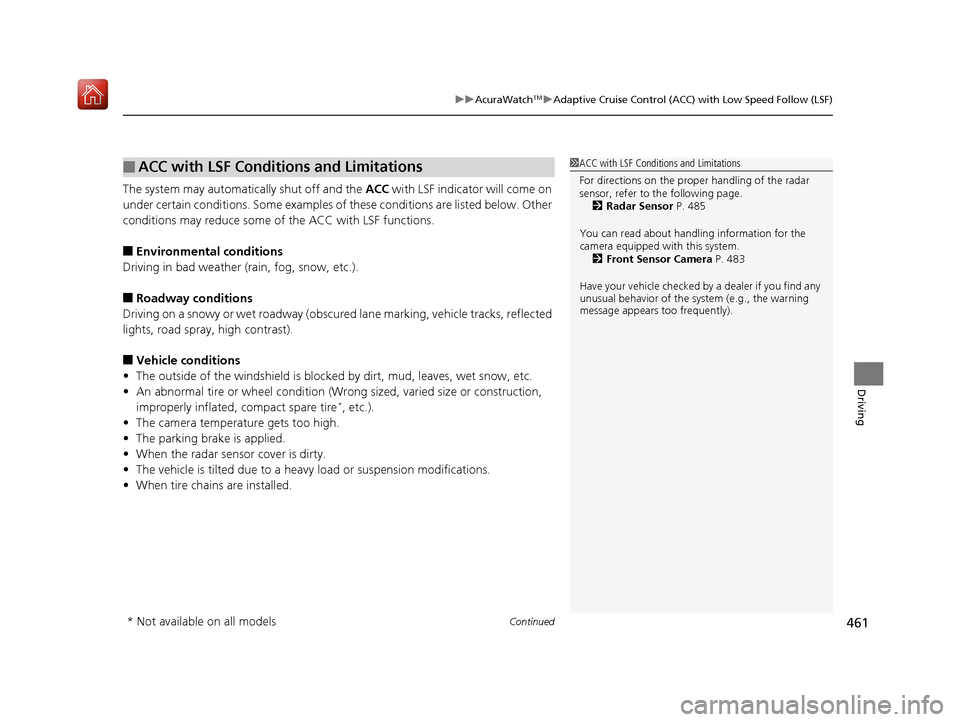
Continued461
uuAcuraWatchTMuAdaptive Cruise Control (ACC) with Low Speed Follow (LSF)
Driving
The system may automatically shut off and the ACC with LSF indicator will come on
under certain conditions. Some examples of these conditions are listed below. Other
conditions may reduce some of the ACC with LSF functions.
Ō¢ĀEnvironmental conditions
Driving in bad weather (r ain, fog, snow, etc.).
Ō¢ĀRoadway conditions
Driving on a snowy or wet roadway (obscure d lane marking, vehicle tracks, reflected
lights, road spra y, high contrast).
Ō¢ĀVehicle conditions
ŌĆó The outside of the windshield is blocked by dirt, mud, leaves, wet snow, etc.
ŌĆó An abnormal tire or wheel condition (Wro ng sized, varied size or construction,
improperly inflated, compact spare tire
*, etc.).
ŌĆó The camera temperature gets too high.
ŌĆó The parking brake is applied.
ŌĆó When the radar sensor cover is dirty.
ŌĆó The vehicle is tilted due to a heavy load or suspension modifications.
ŌĆó When tire chains are installed.
Ō¢ĀACC with LSF Conditions and Limitations1ACC with LSF Conditions and Limitations
For directions on the prop er handling of the radar
sensor, refer to the following page.
2 Radar Sensor P. 485
You can read about handling information for the
camera equipped with this system. 2 Front Sensor Camera P. 483
Have your vehicle checked by a dealer if you find any
unusual behavior of the system (e.g., the warning
message appears too frequently).
* Not available on all models
19 ACURA RDX-31TJB6000.book 461 ŃāÜŃā╝ŃéĖ ’╝Æ’╝É’╝æ’╝śÕ╣┤’╝öµ£ł’╝Æ’╝¢µŚźŃĆƵ£©µø£µŚźŃĆĆÕŹłÕŠī’╝öµÖé’╝Ģ’╝æÕłå
Page 463 of 649
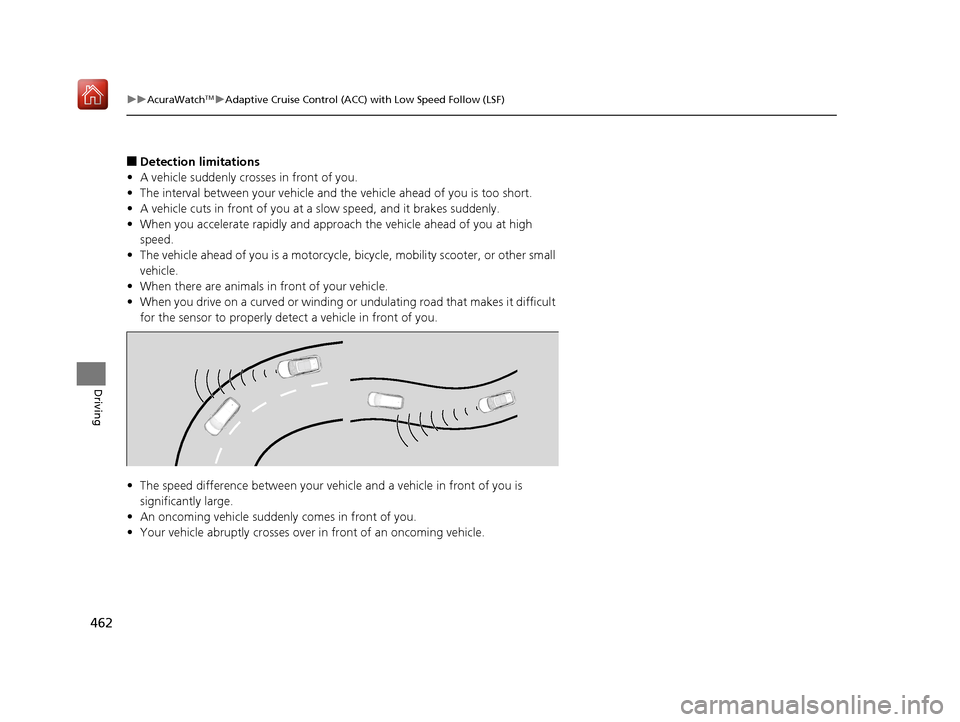
462
uuAcuraWatchTMuAdaptive Cruise Control (ACC) with Low Speed Follow (LSF)
Driving
Ō¢ĀDetection limitations
ŌĆó A vehicle suddenly crosses in front of you.
ŌĆó The interval between your vehicle and the vehicle ahead of you is too short.
ŌĆó A vehicle cuts in front of you at a slow speed, and it brakes suddenly.
ŌĆó When you accelerate rapidly and approach the vehicle ahead of you at high
speed.
ŌĆó The vehicle ahead of you is a motorcycle, bicycle, mobility scooter, or other small
vehicle.
ŌĆó When there are animals in front of your vehicle.
ŌĆó When you drive on a curved or winding or undulating road that makes it difficult
for the sensor to properly dete ct a vehicle in front of you.
ŌĆó The speed difference between your vehicl e and a vehicle in front of you is
significantly large.
ŌĆó An oncoming vehicle suddenly comes in front of you.
ŌĆó Your vehicle abruptly crosses over in front of an oncoming vehicle.
19 ACURA RDX-31TJB6000.book 462 ŃāÜŃā╝ŃéĖ ’╝Æ’╝É’╝æ’╝śÕ╣┤’╝öµ£ł’╝Æ’╝¢µŚźŃĆƵ£©µø£µŚźŃĆĆÕŹłÕŠī’╝öµÖé’╝Ģ’╝æÕłå
Page 469 of 649

uuAcuraWatchTMuAdaptive Cruise Control (ACC) with Low Speed Follow (LSF)
468
Driving
Ō¢ĀAutomatic cancellation
The beeper sounds and a message appears on the multi-information display when
ACC with LSF is automatically canceled. An y of these conditions may cause the ACC
with LSF to automatically cancel:
ŌĆó Bad weather (rain, fog, snow, etc.)
ŌĆó When the radar sensor behind the emblem gets dirty.
ŌĆó The vehicle ahead of you cannot be detected.
ŌĆó An abnormal tire condition is detected, or the tires are skidding.
ŌĆó Driving on a mountainous road, or driving off road for extended periods.
ŌĆó Abrupt steering wheel movement.
ŌĆó When the ABS, VSA ┬« or CMBS
TM is activated.
ŌĆó When the ABS or VSA ┬« system indicator comes on.
ŌĆó When the vehicle is stopped on a very steep slope.
ŌĆó When you manually apply the parking brake.
ŌĆó When the detected vehicle within the ACC with LSF range is too close to your
vehicle.
ŌĆó When a detected vehicle goes out of th e ACC with LSF range while your vehicle
is stationary.
ŌĆó The camera behind the rearview mirror, or the area around the camera, including
the windshield, gets dirty.
ŌĆó When the Maximum Load Limit is exceeded.
ŌĆó When passing through an enclosed space, such as tunnel.
The ACC with LSF automatic cancellation can be also triggered by the following
causes. In these cases, the parking brake will be automatically applied.
ŌĆó The driverŌĆÖs seat belt is unfastened when the vehicl e is stationary.
ŌĆó The vehicle stops for mo re than 10 minutes.
ŌĆó The engine is turned off.
1Automatic cancellation
Even though ACC with LSF has been automatically
canceled, you can still resu me the prior set speed.
Wait until the condition that caused ACC with LSF to
cancel improves, then press the RES/+/SET/ŌĆō switch
down.
19 ACURA RDX-31TJB6000.book 468 ŃāÜŃā╝ŃéĖ ’╝Æ’╝É’╝æ’╝śÕ╣┤’╝öµ£ł’╝Æ’╝¢µŚźŃĆƵ£©µø£µŚźŃĆĆÕŹłÕŠī’╝öµÖé’╝Ģ’╝æÕłå
Page 472 of 649
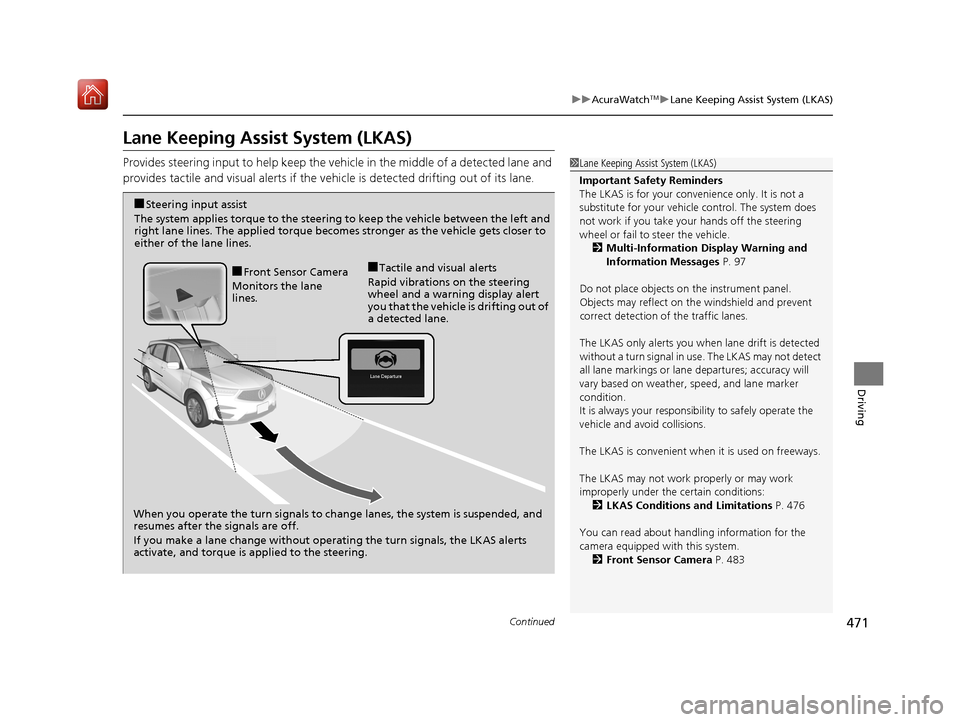
471
uuAcuraWatchTMuLane Keeping Assist System (LKAS)
Continued
Driving
Lane Keeping Assist System (LKAS)
Provides steering input to help keep the vehicle in the middle of a detected lane and
provides tactile and visual al erts if the vehicle is detected drifting out of its lane.1Lane Keeping Assist System (LKAS)
Important Safety Reminders
The LKAS is for your convenience only. It is not a
substitute for your vehicl e control. The system does
not work if you take y our hands off the steering
wheel or fail to steer the vehicle.
2 Multi-Information Display Warning and
Information Messages P. 97
Do not place objects on the instrument panel.
Objects may reflect on th e windshield and prevent
correct detection of the traffic lanes.
The LKAS only alerts you when lane drift is detected
without a turn signal in us e. The LKAS may not detect
all lane markings or lane departures; accuracy will
vary based on weather, speed, and lane marker
condition.
It is always your responsibility to safely operate the
vehicle and avoid collisions.
The LKAS is convenient when it is used on freeways.
The LKAS may not work properly or may work
improperly under the certain conditions:
2 LKAS Conditions and Limitations P. 476
You can read about handling information for the
camera equipped with this system. 2 Front Sensor Camera P. 483
When you operate the turn signals to chan ge lanes, the system is suspended, and
resumes after the signals are off.
If you make a lane change without operating the turn signals, the LKAS alerts
activate, and torque is applied to the steering.
Ō¢ĀFront Sensor Camera
Monitors the lane
lines.Ō¢ĀTactile and visual alerts
Rapid vibrations on the steering
wheel and a warning display alert
you that the vehicle is drifting out of
a detected lane.
Ō¢ĀSteering input assist
The system applies torque to the steering to keep the vehicle between the left and
right lane lines. The applied torque become s stronger as the vehicle gets closer to
either of the lane lines.
19 ACURA RDX-31TJB6000.book 471 ŃāÜŃā╝ŃéĖ ’╝Æ’╝É’╝æ’╝śÕ╣┤’╝öµ£ł’╝Æ’╝¢µŚźŃĆƵ£©µø£µŚźŃĆĆÕŹłÕŠī’╝öµÖé’╝Ģ’╝æÕłå